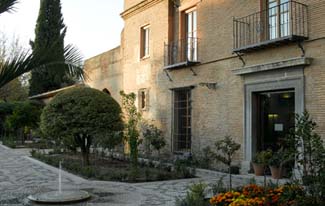
Photos courtesy of Parador de Granada
Real de la Alhambra s/n
18009 Granada
Tel: ++34 958 22 14 40
Fax: ++34 958 22 22 64
Official parador website
Reserve with Booking.com
36 rooms
Rack rates:
Double rooms and suites: 275–743 euros
Rates include tax. Breakfast extra.
Free Wi-Fi
Open: all year
Granada is linked by all means of transportation to Spain’s major cities. If driving, follow the signposts around the city. The parador is to one side of the Alhambra.
Nearby: the Alhambra and Generalife palaces.
Come to the Parador de Granada for the Alhambra but also for its lovely gardens, which are so peaceful in the early morning or evening. Close your eyes and listen to the soft sounds of the birds and fountains; smell the roses and be carried back to the enchantment of Washington Irving’s Tales of the Alhambra. From here, views of the red-roofed houses of Granada and the snowcapped Sierra Nevada are unsurpassed.
Today this parador is the most popular in Spain. It’s lobby and public rooms are filled with antique wood santos (carved figures of saints), carved tables, copper pieces, El Greco reproductions, and works by modern regional artists.
Long corridors lead to the guest rooms framed with carved doorways. Rooms have been remodeled in an unfortunate (my opinion) contemporary design. Windows look out over views of the gardens and Generalife Palace located across a ravine.
Tapestries, embroidered piecework, and copper and iron craftwork decorate the restaurant. The menu offers traditional Andalucian cuisine.
![]() The parador is on the grounds of the magnificent Alhambra.
The parador is on the grounds of the magnificent Alhambra.